
Date: July 5, 2019
Location: Lat: 35.261978°, Lon: -74.873592°
Dive Depth Range: 860-1,034 meters (2,822-3,392 feet)
Access Dive Summary and ROV Data
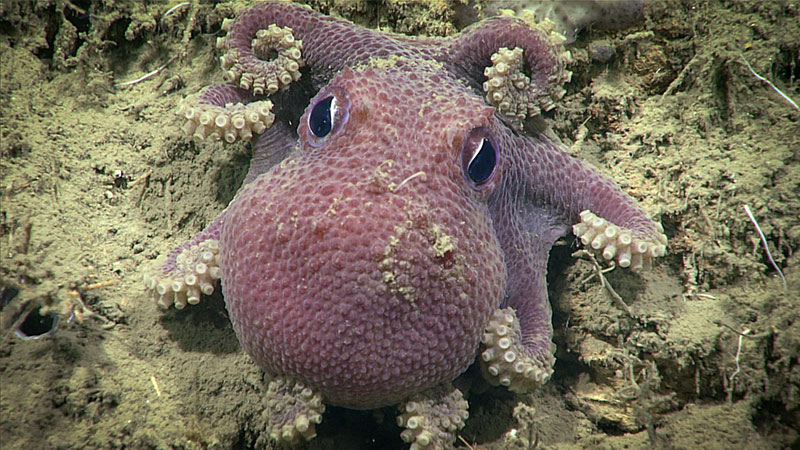
Bathypolypus bairdii. Image courtesy of the NOAA Office of Ocean Exploration and Research, Windows to the Deep 2019. Download larger version (jpg, 1.6 MB).
Today we found ourselves on an unexpected “cephalopod safari,” with a greater diversity of octopus and squid than we’ve seen on our previous dives of the expedition. We landed on a flat spot in a small canyon off the coast of North Carolina, at a depth of 1,034 meters (3,392 feet), where we found a soft, silty seafloor and a fair amount of marine snow and fine sediment in the water column. However, visibility was still far better than it had been on our previous dive. When we reached the bottom, we noticed a large number of short-finned squid (Illex sp.) darting around the seafloor, which seemed to become our near-constant companions on the dive.
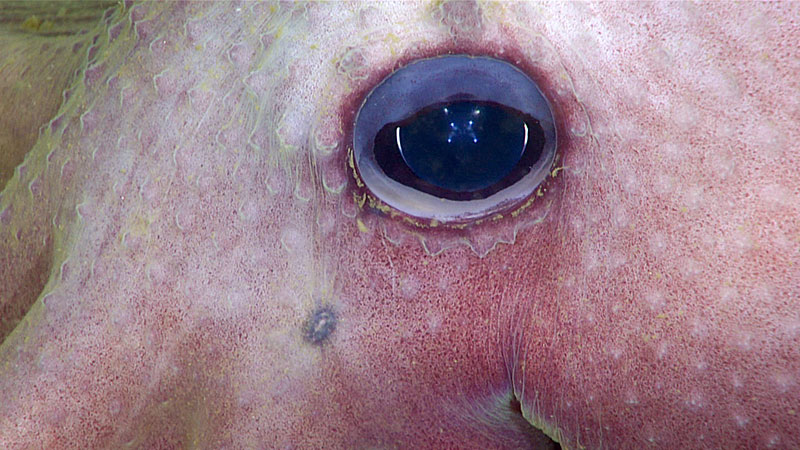
The lights of ROV Deep Discoverer are reflected in the eye of an octopus (genus Graneledone), as seen during the day’s dive. Image courtesy of the NOAA Office of Ocean Exploration and Research, Windows to the Deep 2019. Download larger version (jpg, 1.6 MB).
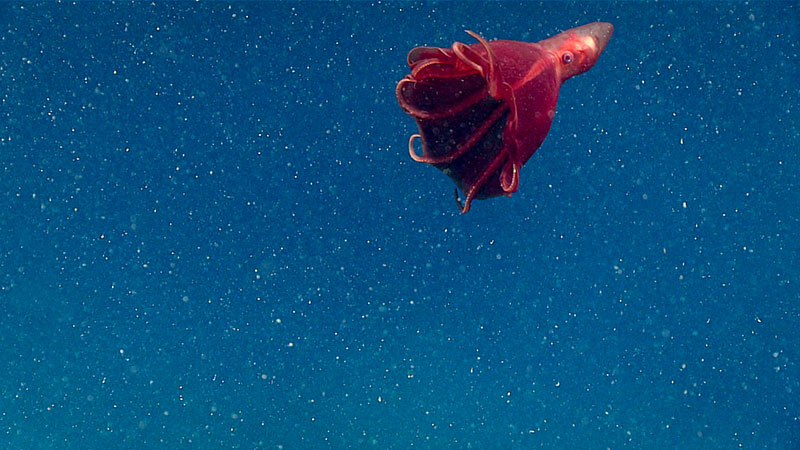
A dumbo octopus, most likely Stauroteuthis syrtensis. Image courtesy of the NOAA Office of Ocean Exploration and Research, Windows to the Deep 2019. Download larger version (jpg, 1.7 MB).
Throughout the dive, we transited up the canyon wall and encountered some areas of exposed hard rock, and along the way, we observed a number of cutthroat eels, eel pouts, a number of fly-trap anemones, and two bobtail squid. Shortly into the dive, we saw the first of what turned out to be many octopods, including a spoon arm octopus (Bathypolypus bairdii); a warty octopus; and to the delight of many watching, a dumbo octopus (Stauroteuthis syrtensis). Aside from the cephalopods, we also saw many many pallid sculpins and snailfish, as well as several red crabs (Chaceon sp.). One particularly eventful species interaction occurred when we stopped to watch a Chaceon crab eating from a bed of pallid scupin eggs, before suddenly retreating as a larger crab approached.
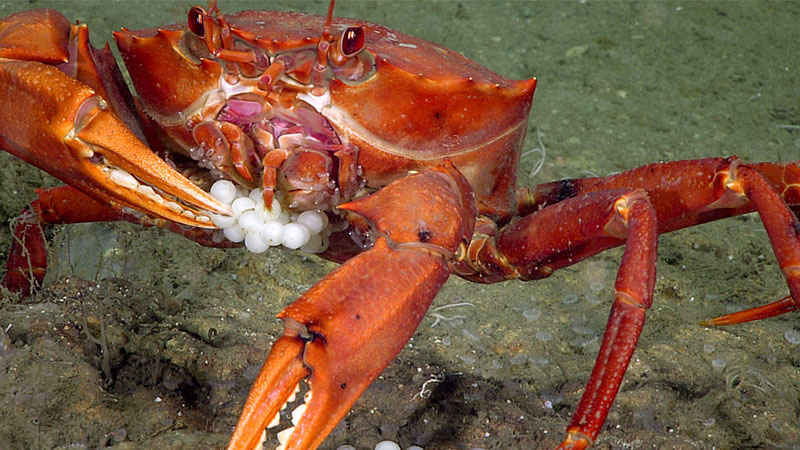
A red crab (Chaceon sp.) feeds on eggs, likely of a pallid sculpin. Image courtesy of the NOAA Office of Ocean Exploration and Research, Windows to the Deep 2019. Download larger version (jpg, 1.5 MB).
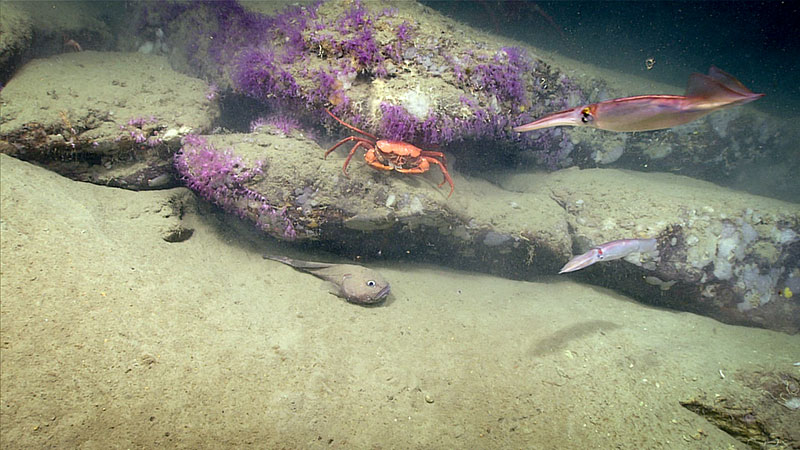
ROV Deep Discoverer came across this red crab (Chaceon sp.) eating the eggs of a pallid sculpin. Image courtesy of the NOAA Office of Ocean Exploration and Research, Windows to the Deep 2019. Download larger version (jpg, 1.4 MB).
During Dive 13, at 920 meters (3,018 feet) depth, we came upon a Chaceon crab perched above a white patch on the seafloor. A closer look revealed the patch to be a cluster of hundreds of eggs, proposed to have been deposited on the rock by a pallid sculpin. As we watched, the crab plucking eggs from the pile with its major chelipeds (clawed legs) and eating them. Furthermore, we observed dozens of amphipods (distant crustacean relatives of the crab) clinging to and crawling over the crab’s mouthparts. For the full story, check out this mission log. Video courtesy of the NOAA Office of Ocean Exploration and Research, Windows to the Deep 2019. Download larger version (mp4, 84.9 MB).
We ended our dive at a depth of about 860 meters (2,822 feet), at which point remotely operated vehicle Deep Discoverer returned to the surface, and we began our usual overnight mapping operations. Of particular interest will be collecting mapping data that will inform tomorrow’s dive (July 6, 2019) and to search for potential underwater cultural heritage sites. Tomorrow’s dive will take place in an area where active bubble plumes were detected on earlier NOAA Ship Okeanos Explorer expeditions and which were confirmed in our mapping efforts yesterday. This activity indicates the presence of an active seep and potentially its associated fauna.
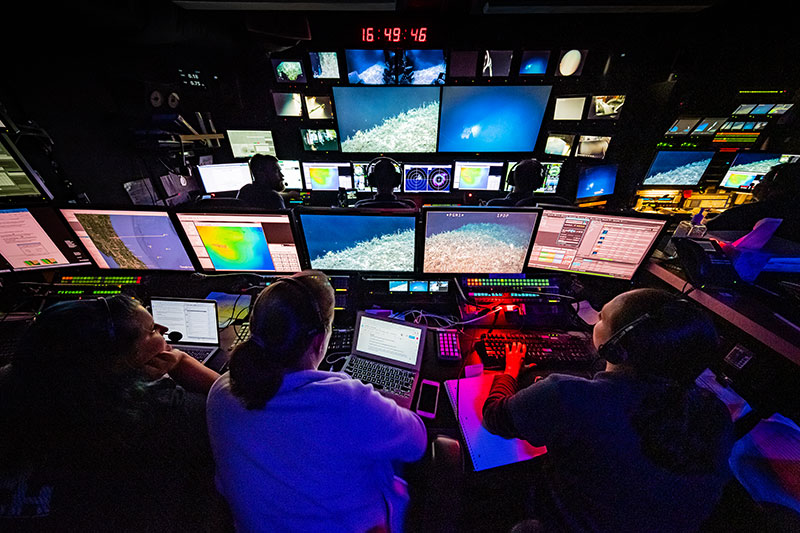
Mission control during an ROV dive onboard NOAA Ship Okeanos Explorer. Image courtesy of the NOAA Office of Ocean Exploration and Research, Windows to the Deep 2019. Download larger version (jpg, 6.3 MB).

Location of Dive 13 on July 5, 2019. Download larger version (jpg, 2.2 MB).

The remotely operated vehicle track for Dive 13, shown as an orange line with a white curtain. Scale is water depth in meters. Download larger version (jpg, 4.5 MB).